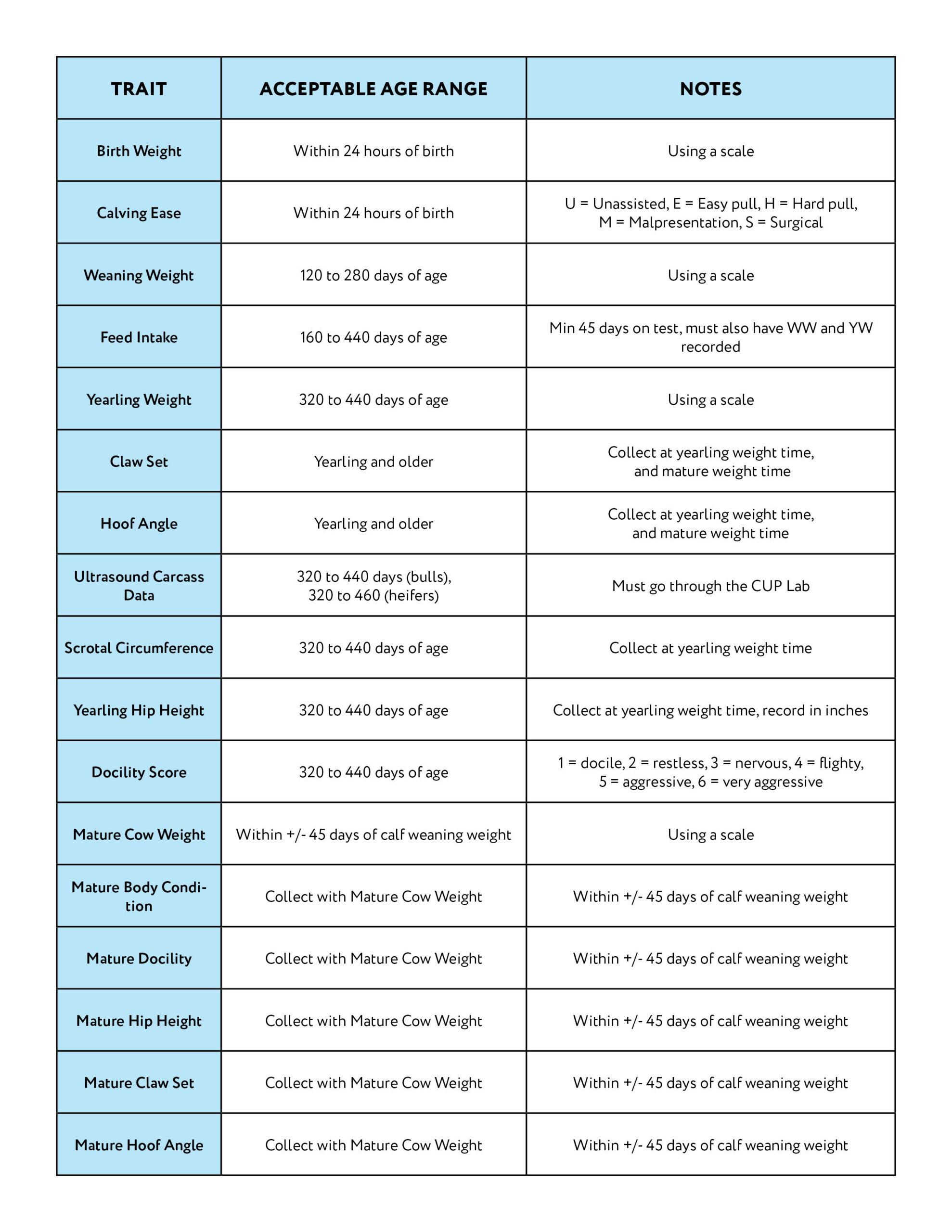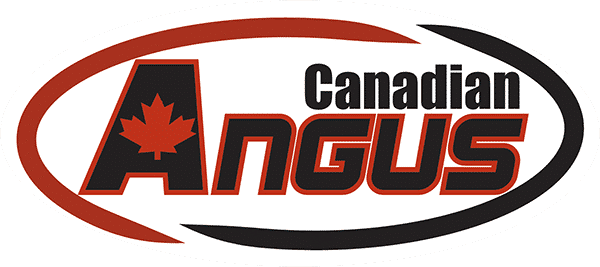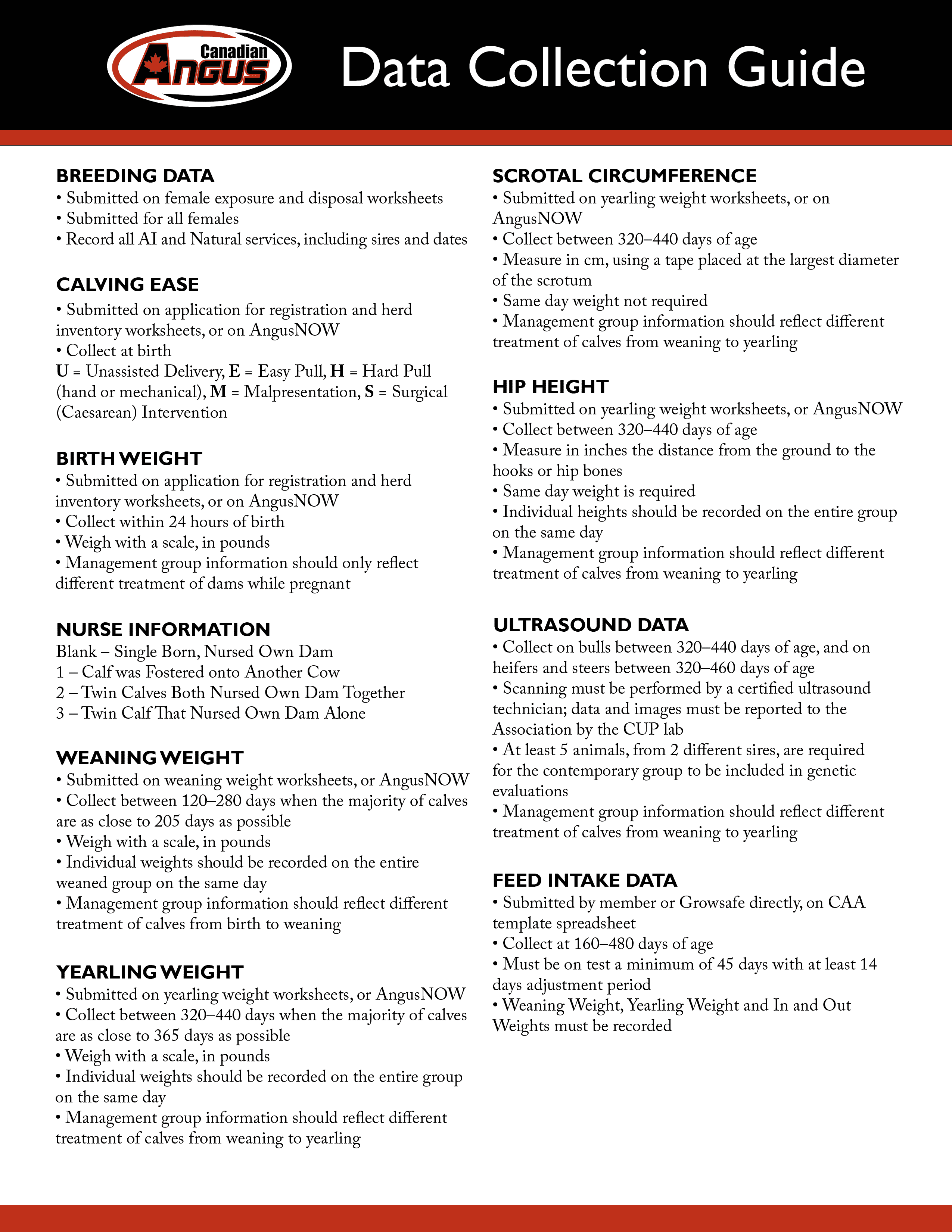Canadian Angus Association members and their commercial customers, in our 2019 survey, identified traits that were important to them in their own operations.
We currently do not have genetic evaluations for these traits. It is evident that our genetic evaluations have to evolve to include traits that are important to our members and their customers. In order to generate EPDs for these traits, we need to collect data on these traits. Herds that collect and submit data on these traits will receive EPDs for these traits.
New traits include high immune response, mature cow weight, height, and body condition score, claw set score and foot angle score, and teat and udder score, residual average daily gain, and docility.
Performance Trait Acceptable Age Range and Notes

Data Collection Guide
BREEDING DATA
Click here for form.
• Submit on female exposure and disposal worksheets
• Submit for all females
• Record all AI and Natural services, including sires and dates
DAM STATUS CODES
11 – Animal on Lease
12 – Open (missed calving opportunity)
13 – ET Donor Dam
14 – ET Recipient Dam
15 – Moved to Next Calving Season
16 – Still to Calve in Current Season
17 – Aborted Calf
MATURE ANIMAL DISPOSAL CODES
1 – Died Disease
2 – Died Age
3 – Died Other
4 – Culled Physical Defect
5 – Culled Fertility
6 – Culled Performance
7 – Culled Temperament
8 – Culled Age
9 – Sold for Breeding (no papers transferred)
10 – Sold for Breeding (transfer forthcoming)
18 – Moved to Commercial Herd
CALF DATA
Click here for form.
CALVING EASE
• Submitted on application for registration and herd inventory worksheets or on AngusNOW
• Collect at birth
U = Unassisted Delivery, E = Easy Pull, H = Hard Pull (hand or mechanical), M = Malpresentation, S = Surgical (Caesarean) Intervention
BIRTH WEIGHT
• Submit on application for registration and herd inventory worksheets or on AngusNOW
• Collect within 24 hours of birth
• Weigh with a scale, in pounds
• Management group information should only reflect different treatment of dams while pregnant
SERVICE TYPE (NATURAL, AI, ET OR BY IVF)
• Submit on application for registration and herd inventory worksheets or on AngusNOW
• Must submit service date for all AI services
• Use first date of exposure for natural services
• ET is Embryo Transfer (use implant date for service date)
• ET by IVF is In-vitro Fertilization (use implant date for service date)
NURSE INFORMATION
Blank – Single Born, Nursed Own Dam
1 – Calf was Fostered onto Another Cow
2 – Twin Calves Both Nursed Own Dam Together
3 – Twin Calf That Nursed Own Dam Alone
CALF DISPOSAL CODES
B – Stillborn (Full Term)
C – Died at Birth (Defect)
D – Died at Birth (Other)
E – Died Before Weaning (Disease)
F – Died Before Weaning (Other)
G – Died After Weaning (Disease)
H – Died After Weaning (Other)
I – Sold (no transfer)
J – Sold (transfer forthcoming)
WEANING WEIGHT
Click here for form.
• Submit on weaning weight worksheets or AngusNOW
• Collect between 120–280 days when the majority of calves are as close to 205 days as possible
• Weigh with a scale, in pounds
• Individual weights should be recorded on the entire weaned group on the same day
• Management group information should reflect different treatment of calves from birth to weaning
YEARLING DATA
Click here for form.
• Submit on yearling weight worksheets or AngusNOW
• Collect between 320–440 days when the majority of calves are as close to 365 days as possible
• Weigh with a scale, in pounds
• Individual weights should be recorded on the entire group on the same day
• Management group information should reflect different treatment of calves from weaning to yearling
SCROTAL CIRCUMFERENCE
• Submit on yearling weight worksheets or on AngusNOW
• Collect between 320–440 days of age
• Measure in cm, using a tape placed at the largest diameter of the scrotum
• Same day weight not required
• Management group information should reflect different treatment of calves from weaning to yearling
HIP HEIGHT
• Submit on yearling weight worksheets or AngusNOW
• Collect between 320–440 days of age
• Measure the distance from the ground to the hooks or hip bones in inches
• Same day weight is required
• Individual heights should be recorded on the entire group on the same day
• Management group information should reflect different treatment of calves from weaning to yearling
DOCILITY SCORE
• Submit on AngusNOW and CAA worksheets
1 = Docile (acceptable, mild disposition)
2 = Restless (restless during processing)
3 = Nervous (nervous and impatient)
4 = Flighty (jumpy and out of control, quivers and struggles)
5 = Aggressive (extreme agitation)
6 = Very Aggressive (extremely violent behaviour)
FEET AND LEG SCORING
Click here for form.
• Submit on AngusNOW and CAA worksheets
• Collect on date of yearling weight and subsequently when scoring mature cow weight on untrimmed cattle
• Management group information includes animals that were fed and pastured the same
• Foot and claw scores range from 1–9 (see chart)
• Leg scoring (rear leg side view and rear leg rear view) ranges from 1–9 (see chart)
ULTRASOUND DATA
Click here for form.
• Collect on bulls between 320–440 days of age, and on heifers and steers between 320–460 days of age
• Scanning must be performed by a certified ultrasound technician; data and images must be reported to the Association by the CUP lab
• At least 5 animals, from 2 different sires, are required for the contemporary group to be included in genetic evaluations
• Management group information should reflect different treatment of calves from weaning to yearling
FEED INTAKE DATA
• Submit by member or Growsafe directly, on CAA template spreadsheet
• Collect at 160–480 days of age
• Must be on test a minimum of 45 days with at least 14 days adjustment period
• Weaning Weight, Yearling Weight and In and Out Weights must be recorded
CARCASS DATA
• Submit on CAA template spreadsheet
• Calves must be at least sire verified; dams must be identified
• Calf tattoo, date of birth and sex must be recorded
• Collect harvest data between 360 and 660 days of age
• At least 5 animals, from 2 different sires, are required for the group to be included in genetic evaluations
• Carcass traits recorded include:
- Harvest plant and location
- Hot carcass weight
- Marbling score (e.g., MD30)
- Carcass maturity
- Fat thickness
- Ribeye area
- Percent pelvic, heart, and kidney fat, if available
- Quality grade
- Yield grade
MATURE COW DATA
Click here for form.
MATURE COW BODY CONDITION SCORE
• Submit on AngusNOW or on CAA worksheets
BCS 1 = Bone structure of shoulder, ribs, back, hooks and pins are sharp and easily visible, no fat deposits or muscling.
BCS 2 = No fat deposition, some muscling in the hindquarters, the spine feels sharp to the touch.
BCS 3 = Beginning of fat cover over the loin, back and fore ribs, the backbone is still highly visible.
BCS 4 = Fore ribs are not noticeable but the 12th and 13th ribs are still noticeable to the eye. Spine can be felt with slight pressure and feels rounded.
BCS 5 = The 12th and 13th ribs are not visible to the eye. The backbones can only be felt with firm pressure but are not noticeable to the eye, areas on each side of the tail head are well filled but not mounded.
BCS 6 = Ribs are fully covered, hindquarters are plump and full, noticeable sponginess over the fore ribs and on each side of the tail head.
BCS 7 = Abundant fat cover on either side of the tail head with evident patchiness.
BCS 8 = Animal takes on a smooth, blocky appearance, bone structure disappears from sight, fat cover is thick and spongy.
BCS 9 = Bone structure is not seen or felt, tail head is buried in fat, the animal’s mobility may actually be impaired by excessive fat.
MATURE COW WEIGHT
• Submit on AngusNOW
• Must be taken +/- 45 days of calf’s weaning weight date
• Must be taken with a body condition score
TEAT AND UDDER SCORING
Click here for form.
• Submit on AngusNOW and CAA worksheets
• Collect within 72 hours of calving
• Udder suspension and teat size scores range from 1–9 (see chart)




